Almost everyone who was once a schoolchild knows the game "Battleship", playing which you can have a wonderful time on a trip or a break. Into the game sea battle"Two people play. To play "sea battle" a regular checkered sheet is suitable, which can be downloaded and printed on our website.
However, specifically for the game "battleship", you can print a table for two players on this page. The battleship game can only be played by two people or two teams. First, players draw a fleet of ships on their field. The fleet consists of: one ship - a row of four cells - "four-deck", two ships - a row of 3 cells - "three-deck", three ships - a row of two cells - "double-deck" and four ships - a row of one cell - "single-deck" ". At the bottom of the tables for playing "sea battle", which can be downloaded and printed below, you can see which ships the player has and in what quantity. When drawing, ships cannot touch each other at their corners and cannot be positioned diagonally. The decks of ships should be located in one line vertically or horizontally. Ships can touch the edges of the field, but not each other. The second field is used by the player to mark moves already made and “destroyed” enemy ships. Otherwise, the player may forget which cells he has already “shot” and which he has not.
Once the ships are positioned, players draw lots to see who starts first. After this, each player takes turns calling the coordinates of the ships on the enemy’s map, for example, “D-2”. The Battleship tables below already contain 10v10 tables for two players with numbered spaces. If the player has an enemy ship at the specified coordinates, then the entire ship or part of it is considered damaged. A player who has made an effective move has the right to make another one without a turn.
Print the table for the game "sea battle" on A4 or download
You can print the table for the game "sea battle" on A4 sheet in PDF or Word format. Printable PDF and editable RTF files can be found at the links below. The file contains one A4 sheet with tables for two players.
 |
|
 |
Also on our website, in the lined sheets section, you can simply print a sheet in a square or line.
A couple of days ago, I was surprised to learn that some of my friends do not know how to play sea battle. Those. They, of course, know the rules, but they play somehow haphazardly and in the end they often lose. In this post I will try to outline the main ideas that will help improve your game.
Rules of the game
There are many options for naval combat, but we will consider the most common option with the following set of ships:All listed ships must be placed on a square field of 10 by 10 cells, and the ships cannot touch either the corners or sides. The playing field itself is numbered from top to bottom, and the verticals are marked with Russian letters from “A” to “K” (the letters “Y” and “Y” are skipped).
An enemy field of similar size is drawn nearby. If there is a successful shot at the enemy ship, a cross is placed on the corresponding cell of the enemy field and a second shot is fired; if the shot is unsuccessful, a dot is placed in the corresponding cell and the turn goes to the enemy.
Optimal strategy
There is always an element of randomness in a naval battle game, but it can be kept to a minimum. Before moving directly to the search for the optimal strategy, it is necessary to voice one obvious thing: the probability of hitting an enemy ship is higher, the fewer unchecked cells are left on his field, similarly, the probability of hitting your ships is lower, the more unchecked cells are left on your field. That. To play effectively, you need to learn two things at once: optimal shooting at the enemy and optimal placement of your ships.In the following explanation the following notation will be used:

Optimal shooting
The first and most obvious rule for optimal shooting is the following rule: do not shoot at the cells directly surrounding the destroyed enemy ship.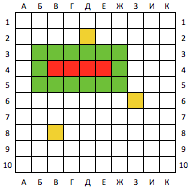
In accordance with the notation adopted above, in the figure, those cells on which unsuccessful shots have already been fired are marked in yellow, cells on which shots ended in hits are marked in red, and cells on which were not fired were marked in green, but it can be guaranteed that the ships there are no ships in them (there cannot be ships there, because according to the rules of the game, ships cannot touch).
The second rule immediately follows from the first rule: if you manage to knock out an enemy ship, you must immediately finish it off in order to get a list of guaranteed free cells as early as possible.
The third rule follows from the first two: you must first try to knock out the largest enemy ships. This rule may not be obvious to you, but if you think a little, you can easily notice that by destroying an enemy battleship, at best, we will immediately receive information about 14 guaranteed free cells, and by destroying a cruiser, only about 12.
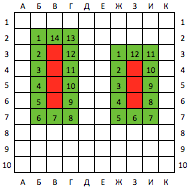
That. The optimal shooting strategy can be reduced to a targeted search and destruction of the largest enemy ships. Unfortunately, it is not enough to formulate a strategy; it is necessary to propose a way to implement it.
First, let's look at a section of the playing field measuring 4 by 4 cells. If there is an enemy battleship in the area in question, then it is guaranteed to be knocked out in no more than 4 shots. To do this, you need to shoot so that there is exactly one checked cell on each horizontal and vertical line. All variants of such shooting are presented below (without taking into account reflections and rotations).
Among all these options, only the first two options are optimal on a 10 by 10 square field, guaranteeing a hit to the battleship in a maximum of 24 shots.
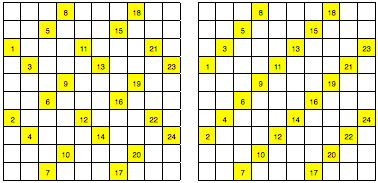
After the enemy battleship is destroyed, it is necessary to begin the search for cruisers, and then destroyers. In this case, as you already guessed, you can use a similar technique. Only now it is necessary to divide the field into squares with a side of 3 and 2 cells, respectively.
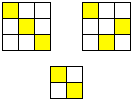
If you used the second strategy when searching for a battleship, then to search for cruisers and destroyers you need to shoot at the following fields (fields that you have already shot at when searching for a battleship are marked in green):
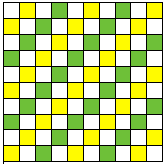
There is no optimal strategy for finding boats, so at the end of the game you have to rely mainly on luck.
Optimal placement of ships
The optimal ship placement strategy is in some ways the inverse of the optimal shooting strategy. When shooting, we tried to find the largest ships in order to reduce the number of cells that needed to be checked by guaranteeing free cells. This means that when placing ships, they must be placed in such a way that in case of their loss, the number of guaranteed free cells is minimized. As you remember, a battleship in the center of the field opens 14 fields for the enemy at once, but a battleship standing in the corner opens only 6 fields for the enemy:Likewise, a cruiser standing in the corner opens only 6 instead of 12 fields. Thus, by placing large ships along the border of the field, you leave more space for boats. Because There is no strategy for finding boats, the enemy will have to shoot at random, and the more free fields you have left by the time you catch the boats, the harder it will be for the enemy to win.
Below are three ways to deploy large ships that leave plenty of room for boats (in blue):

Each of the above arrangements leaves exactly 60 free cells for boats, which means that the probability of accidentally getting into a boat is 0.066. For comparison, it’s worth giving a random arrangement of ships:
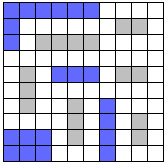
With this arrangement, only 21 cells remain for boats, which means that the probability of hitting a boat is already 0.19, i.e. almost 3 times higher.
In conclusion, I would like to say that you should not spend too much time playing naval battle. I especially want to warn you against playing during lectures. While I was sitting in Wabi-Sabi playing battleship with my girlfriend, a waitress walked by and said that she was quite good at playing because... I practiced a lot in pairs. Who knows what she would have worked like if she had listened to lectures in her time?
P.S. The comments absolutely correctly indicate that there were already similar publications on the hub; it would be wrong not to provide links to them.
The game "Battleship" has been helping people pass the time during classes, lectures, lunch breaks, or just on cold winter evenings for more than 80 years. During this time, many generations have changed, but the game still remains relevant. Although it is being replaced by more modern and dynamic computer games, today it is almost impossible to find a schoolchild who does not know how to play naval battle and what it even is. I will tell you about the rules of the game, and also describe winning tactics. Let's look at how to play sea battle.
Rules of the game
Each player's playing field is a 10x10 square on which ships are placed. The field must contain numeric and alphabetic coordinates (vertical numbers are 1-10, and horizontally letters are from a to k). For the classic game, four one-cell ships (submarines), three two-cell ships (destroyers), two three-cell ships (cruisers) and one four-cell ship (battleship) are used. They are drawn inside the square. According to the rules, the ships should not touch each other. It is best to play on a sheet of paper with a square, because the drawing of ships is a circle of squares. One deck - one cell. Ships can be placed both horizontally and vertically. Next to his square, the player draws a second one, on which he marks “shots” at the enemy. When hitting an opponent's ship, a cross is placed on the opponent's field. The hit player fires another shot.
Violations
- The number of ships does not correspond to the rules
- The ships are located close to each other
- Changed field size
- Incorrect coordinates specified
Game process
- Players decide who will go first
- The player making the move names the coordinate where, in his opinion, the opponent's ship is located. For example, square A1.
- If he misses, the opponent must say “Miss!”; if he hits, “Hit,” “Wounded,” or “Killed,” depending on the size of the ship.
- The game continues until all the ships of one of the players are sunk.
How to win a sea battle
This strategy is one of many options for building a battle. Its essence lies in the fact that all large ships (from two to four cells) are located in one corner of the field and as compactly as possible. But single-celled ships are scattered throughout the rest of the field. As a result, your opponent will quickly find a grouping area of large ships quite quickly and begin to mercilessly destroy them. At this moment he will feel like a real genius, but we know what the catch is. During the time that your opponent spends searching for small ships, you will most likely have time to understand his tactics and destroy most of the ships, thereby making him nervous. The rest is a matter of technique. This article talked about the rules, the process of the game and gave examples of winning tactics on how to win a sea battle. With the right approach, all of the above can serve as a good knowledge base for getting maximum pleasure from the game.
Children are so captivated by various gadgets that they often don’t want to not only read, but even play non-virtually. This worries both specialists and parents. In one of the episodes of the cartoon “Barboskiny”, Grandfather offers a way to return children to the real world by playing the usual “Battleship” on paper with the whole family.
To do this, he turns off the electricity in the house, and the grandchildren are forced to master the game, which does not require any special conditions. He showed that you can have an interesting time without any Internet, armed only with a pen and your own mind.
Although this board game Naval combat today also exists in a computer version, but the traditional version of destroying ships on a checkered piece of paper has one undoubted advantage over the virtual one.
Playing with a living person is more interesting than playing with a computer; the battle is much more fun and exciting. And it’s more useful, because in this case the child develops not only logic and strategic thinking, but also intuition, the ability to “calculate” and read the emotions of another person.
Another plus and the reason for the long popularity of the game is the simplicity of its organization. In order to lead ships into battle, you do not need the Internet, electricity, a large room or any special surroundings. Enough paper, a pen and knowledge of sea battle on paper for two.
Learning to play sea battle
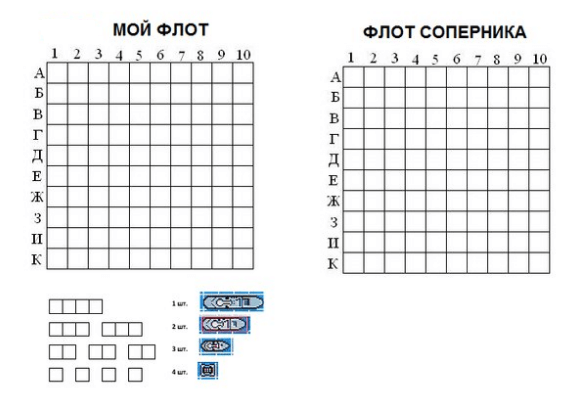
The rules for naval battle for two people are quite simple. On paper, each player must draw a square of 10x10 cells, which are designated on one side with letters from A to K (without E and J), on the other with numbers from 1 to 10. In this field you need to place your ships.
A second similar square with similar field designations is drawn nearby. On it, during the battle, the player records his shots.
- When making a “shot,” the player names the coordinates of the target, for example, B8.
- The opponent answers “by” if there is nothing in the square; "wounded" if his ship was hit; "killed" when the ship is destroyed.
- Hitting someone else's ship is indicated by a cross. In this case, the rules give the right to the next shot.
- If you miss, the right to shoot passes to the second player. The winner is the one who first destroys all enemy ships.
- At the end of the game, the participant can demand that the opponent show his playing field and compare the records of moves.
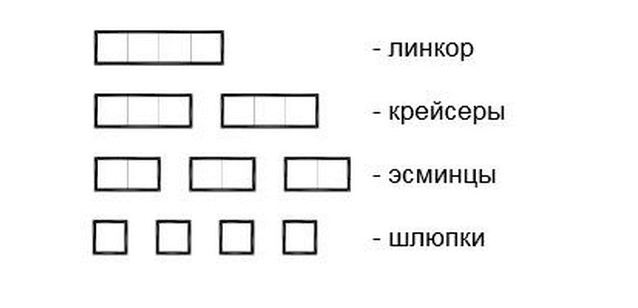
The rules of the game Sea Battle stipulate not only how many and what size ships participate in the battle, but also their location.
- Ship composition: 4 submarines of one cell, 3 destroyers of two cells, 2 cruisers of three cells and one four-cell battleship.
- The ships must be drawn so that they do not touch each other under any circumstances. There must be a distance of at least one cell between them.
- Ships can be positioned horizontally, vertically, or at the edge of the playing field.
What not to do
They stipulate rules and certain restrictions.
- The composition of ships cannot be changed.
- Some rules say that one ship can only have a linear shape; in some options, the shape of the letter L is allowed. This point must be discussed in advance. But in all variants you cannot draw and place ships diagonally.
- The field value cannot be changed.
- You cannot distort the coordinates and hide the hit.
Strategies

Not only simple rules and the conditions for organizing the game explain the popularity of the game Sea Battle, but also the fact that winning in it is determined not only by luck, but also by the right strategy and tactics. This is a game of two people, which means that emotions and cunning are added to logic. Therefore, a winning strategy involves:
- Under no circumstances should your opponent be able to see your playing field.
- Consider your opponent's skill and way of playing. For example, if your opponent is a novice player, then you should not place your ships in the corners of the field. Inexperienced players often start with them, especially with the move A1. If an experienced and long-time opponent is playing with you, who already knows that there can’t be any in the corners of your ships, then it’s worth breaking the pattern and hiding a couple there.
- Think about the location of your ships. One of the winning strategies is to arrange large ships compactly in one place, and single-celled ships scattered away from each other. Then the player, having quickly found large ships, will spend a lot of time searching for small submarines. This will give you time and a chance to recoup.
Winning tactics
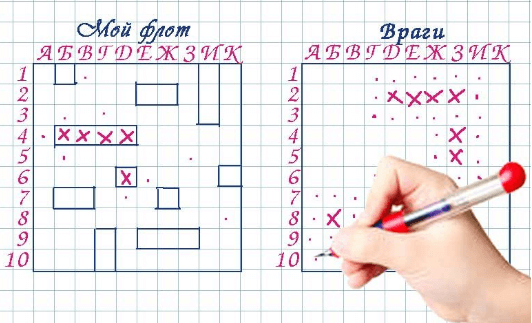
The correct tactics of the game include several simple techniques.
Be sure to record your opponent's moves on your field, and all your moves on the second playing field. Not only hits are indicated, but also misses. Some do it with dots, others with crosses. This will avoid repeated shelling of empty squares and conflicts in case of any errors.
If the opponent’s ship is “killed” in a naval battle, then the cells surrounding it are immediately marked as empty. After all, we know that the rules prohibit placing ships in them. This saves you time. In this case, the most advantageous shot is at the battleship. Its destruction immediately opens eighteen cells, almost a fifth of the field.
Players' shooting tactics can also be different. You can shoot while making diagonal moves. This way there is a greater chance of catching large ships. You can, in search of a profitable battleship, shoot through three cells to the fourth. After the first hits, the choice of moves is determined based on what begins to appear on the enemy playing field.
Tactics to combat popular fraud, when the opponent displays the last single-deck ship already during the game in the last free cell. To make such deception impossible, the field and ships are drawn in one color, and shots are indicated with a different pen or pencil.
Today, the game Battleship exists both as a tabletop factory set and as a computer game, but playing on a simple checkered piece of paper is still exciting.
Let's play "Sea Battle"
Do you play naval battle but don't always win? Then you are probably interested in learning how to significantly increase your chances of winning, how to place your ships correctly, how to quickly destroy enemy ships and, of course, how to win the game Battleship!
Rules of the game "Sea Battle"
There are many options for naval combat, but we will consider the most common option with the following set of ships:
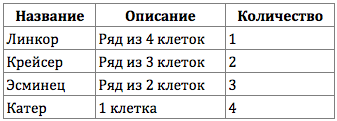
All listed ships must be placed on a square field of 10 by 10 cells, and the ships cannot touch either the corners or sides. The playing field itself is numbered from top to bottom, and the verticals are marked with Russian letters from “A” to “K” (the letters “Y” and “Y” are skipped).
An enemy field of similar size is drawn nearby. If there is a successful shot at the enemy ship, a cross is placed on the corresponding cell of the enemy field and a second shot is fired; if the shot is unsuccessful, a dot is placed in the corresponding cell and the turn goes to the enemy. Optimal strategy
How to win the game Sea Battle
There is always an element of randomness in a naval battle game, but it can be kept to a minimum. Before moving directly to the search for the optimal strategy, it is necessary to state one obvious thing: the probability of hitting an enemy ship is higher, the fewer unchecked cells are left on his field, similarly, the probability of hitting your ships is lower, the more unchecked cells are left on your field. Thus, to play effectively, you need to learn two things at once: optimal shooting at the enemy and optimal placement of your ships.
In the following explanation the following notation will be used:

How to shoot at enemy ships
The first and most obvious rule for optimal shooting is the following rule: do not shoot at the cells directly surrounding the destroyed enemy ship.

In accordance with the notation adopted above, in the figure, those cells on which unsuccessful shots have already been fired are marked in yellow, cells on which shots ended in hits are marked in red, and cells on which were not fired were marked in green, but it can be guaranteed that the ships there are no ships in them (there cannot be ships there, because according to the rules of the game, ships cannot touch).
The second rule immediately follows from the first rule: if you manage to knock out an enemy ship, you must immediately finish it off in order to get a list of guaranteed free cells as early as possible.
The third rule follows from the first two: you must first try to knock out the largest enemy ships. This rule may not be obvious to you, but if you think a little, you can easily notice that by destroying an enemy battleship, at best, we will immediately receive information about 14 guaranteed free cells, and by destroying a cruiser, only about 12.

Optimal shooting strategy
That. The optimal shooting strategy can be reduced to a targeted search and destruction of the largest enemy ships. Unfortunately, it is not enough to formulate a strategy; it is necessary to propose a way to implement it.
First, let's look at a section of the playing field measuring 4 by 4 cells. If there is an enemy battleship in the area in question, then it is guaranteed to be knocked out in no more than 4 shots. To do this, you need to shoot so that there is exactly one checked cell on each horizontal and vertical line. All variants of such shooting are presented below (without taking into account reflections and rotations).
Among all these options, only the first two options are optimal on a 10 by 10 square field, guaranteeing a hit to the battleship in a maximum of 24 shots.
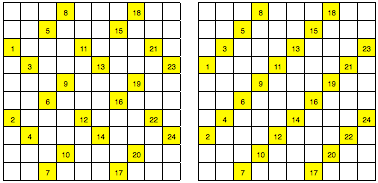
After the enemy battleship is destroyed, it is necessary to begin the search for cruisers, and then destroyers. In this case, as you already guessed, you can use a similar technique. Only now it is necessary to divide the field into squares with a side of 3 and 2 cells, respectively.



